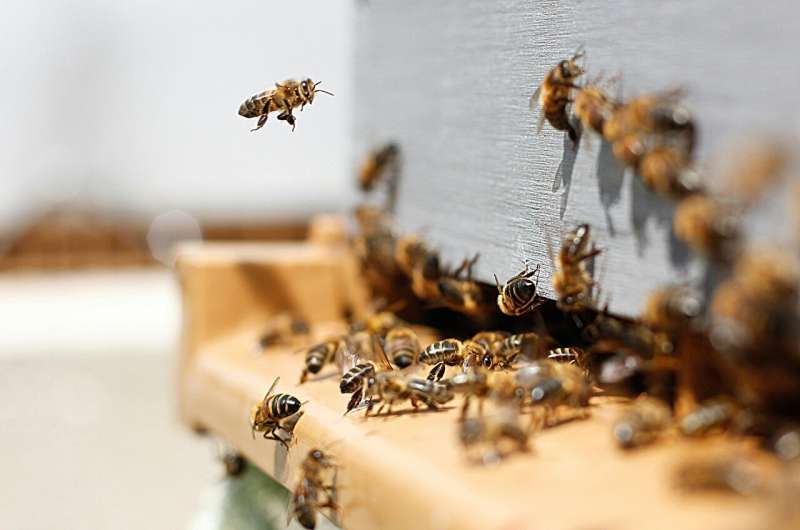This article has been reviewed according to Science X's editorial process and policies. Editors have highlighted the following attributes while ensuring the content's credibility:
fact-checked
peer-reviewed publication
trusted source
proofread
Honey bees may play key role in spreading viruses to wild bumble bees

Honey bees may play a role in increasing virus levels in wild bumble bees each spring, according to researchers at Penn State who analyzed seasonal trends of parasite and virus transmission in bees.
The study—published in the journal Ecosphere—found that honey bees consistently had higher levels of viruses than bumble bees. Additionally, while both types of bees had lower virus prevalence in the winter, only bumble bees experienced negligible levels in spring.
Heather Hines, associate professor of biology and entomology in the College of Agricultural Sciences and corresponding author on the study, said this suggests that honey bees may be reinfecting bumble bees that otherwise would have very low virus prevalence each spring.
She added that the findings help improve the understanding of how pathogens may be transmitted between wild and managed bees, as well as why pathogens in bees are changing and what can be done to reduce them.
"Our data suggests that healthy wild bee communities require healthy honey bee colony management," she said. "Practices that help reduce disease loads in honey bees include ensuring cross-season high-quality nutrition, reducing pesticides and mitigating Varroa mites, which are known to be responsible for higher late-season viral loads."
Hines explained that while the study points to honey bees as spring viral reservoirs, this doesn't mean that honey bees are bad, but rather that good honey bee colony management is important for healthy pollinator communities.
Around the globe, the majority of food crops and wild plants rely on pollinators for reproduction. Agriculture benefits greatly from managed honey bee colonies to pollinate plants, while native bee species like bumble bees and solitary bees provide natural pollination services, can enhance fruitset—when a flower turns into fruit—and are necessary for the pollination of many plant species.
Bumble bees, unlike honey bees, are native to the United States and are the dominant ancestral pollinators of crops native to the region, such as blueberries and cranberries. Meanwhile, honey bees, which originated in Asia, are superior pollinators of most orchard crops given their ability to mass recruit members to these resources.
Hines said that while these different types of bees have many traits in common, they also have differences that can affect dynamics like the spread of parasites and viruses.
"Honey bees are managed bees that are perennial, while bumble bees are annual—overwintering as new queens and starting and growing their colonies in the following spring," she said. "These differing colony dynamics likely impact how diseases are spread between managed and native bees."
Many different pests and diseases can wreak havoc on bee populations, with several capable of spreading across multiple bee species. For example, deformed wing virus (DWV) and black queen cell virus (BQCV) are both harmful to and can be spread between honey and bumble bees. Additionally, harmful parasites such as nematodes and parasitic flies can also spread among bee populations.
For this study, the researchers aimed to examine whether and how seasonal trends affected both virus and parasite spread. They collected both bumble and honey bees at multiple time periods across four years at six different sites in Centre County.
Then, the researchers screened for DWV and BQCV in bee abdomens using molecular biomarkers and for protozoan pathogens and parasites using a microscope. Finally, they compared the prevalence of these viruses and pests in the different bee species across different times of the years.
The researchers found that DWV and BQCV were common in both bumble and honey bees, with both species experiencing higher levels of DWV in the fall and higher levels of BQCV in mid-season. However, honey bees harbored higher levels of both viruses year-round.
Hines said the most noticeable seasonal difference occurred in the spring.
"Bumble bees had negligible levels of viruses in the spring, suggesting queens are either resistant or die during overwintering if infected," she said. "Honey bee colonies tend to have lower viral prevalence by spring as well, however, they still retain fairly high viral levels compared to bumble bees. This means that honey bees serve as a viral reservoir that can reinfect native bee communities that would naturally purge these viruses in the spring."
Hines said the study adds to a growing amount of research on the role of managed honey bees on disease loads in bee communities. The Hines Lab, specifically, has been involved in research examining the role of landscapes in the eastern United States on bumble bee pathogen loads, seeking to better understand which factors can be managed to most impact disease in these bees.
The researchers said that in the future, further studies on queen immunity and vulnerability to pathogens will better inform the understanding of these patterns.
Briana Wham, who earned her doctorate degree in entomology from Penn State and is currently a Penn State research data librarian, is first author on the paper. Elyse McCormick, who was a research technician at Penn State and is now a doctoral candidate at the University of Massachusetts—and several Penn State alumni who contributed to the research as undergraduate students, including Casey Carr, Nicole Bracci, Ashley Heimann, Timothy Egner and M. Jesse Schneider—co-authored the study.
More information: Briana E. Wham et al, Comparison of seasonal viral prevalence supports honey bees as potential spring pathogen reservoirs for bumble bees, Ecosphere (2024). DOI: 10.1002/ecs2.4883
Journal information: Ecosphere
Provided by Pennsylvania State University


















